This is a KMZ Iskra, a folding medium format camera that shoots 6cm x 6cm images on 120 format roll film. The Iskra is a copy of the AGFA Super Isolette first introduced in 1954, and was made by KMZ (Krasnogorsky Mekhanichesky Zavod), just outside of Moscow starting in 1960. Like the AGFA it copies, the Iskra has a long list of features including a coupled coincident image rangefinder, double image prevention, automatic stop film advance, an automatic exposure counter, and a high quality Tessar style lens. The Iskra is generally regarded as one of the better Soviet copies in that it worked just as well as the original, with little to no obvious “cut corners” in it’s build quality.
 Film Type: 120 Roll Film (twelve 6cm x 6cm exposures per roll)
Film Type: 120 Roll Film (twelve 6cm x 6cm exposures per roll)
Lens: 7.5cm f/3.5 Industar-58 coated 4-elements
Focus: 1 meter to Infinity
Viewfinder: Coincident Image Coupled Rangefinder
Shutter: FXCh-18 Leaf
Speeds: B, 1 – 1/500 seconds
Exposure Meter: None
Battery: None
Flash Mount: Coldshoe and M and X Flash Sync
Weight: 855 grams
Manual: https://www.cameramanuals.org/russian_pdf/iskra_iskra-2-english.pdf
How these ratings work |
The Iskra is a Soviet copy of the AGFA Super Isolette and perfectly matches that camera in quality and features. This is a very well built 6×6 folding camera that has all of the features you’d expect from a fine German camera of the era. Images from the 4-element Industar lens are very good, and the view through the large and bright coupled rangefinder are easy to use with prescription glasses. The Iskra is one example of a Soviet copy that lives up to the reputation of the original. | ||||||
| Images | Handling | Features | Viewfinder | Feel & Beauty | History | Age | |
| 2 | 2 | 1 | 2 | 1 | 1 | 20% | |
| Bonus | none | ||||||
| Final Score | 10.8 | ||||||
History

By the start of World War II, the Soviet Union already had an established optics industry with factories in Leningrad, Kiev, and other cities. The struggle with those locations however, was that they were within striking distance of the invading Germans and by the early 1940s, many were either completely destroyed or abandoned by the Soviets.
On February 1, 1942, by order of the USSR People’s Commissar of Armaments No. 63, an old aircraft factory in Krasnogorsk that was previously evacuated a year earlier was established as State Union Optical Plant No. 393, with the purpose of building aerial optical equipment such as scopes and other photographic equipment.
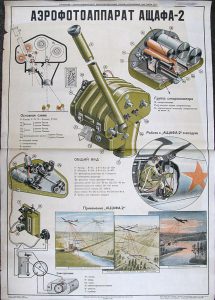
One of the first cameras produced at Plant 392 was the АЩАФА-2 (ASCHAFA-2), a slot hole aerial camera which was used primarily for photo reconnaissance.
In 1946, after the defeat of the Germans, the Soviet Union would claim as war reparations, much of the machinery and equipment from Zeiss plants in Dresden and Jena. At this same time, the factory received the formal name Красногорский механический завод (Krasnogorskiy Mechanicheskiy Zavod) and it’s symbol a dove prism with a ray of light reflecting through it.
The first consumer products manufactured at KMZ were Москва-1 (Moskva-1) cameras. The Moskva-1 was an almost identical copy of the Zeiss Ikonta 6×9 folding camera. The earliest cameras were built using left over Zeiss parts and Compur shutters, making them quite collectible.
Immediately following the war, the KMZ plant bore a large responsibility of re-launching the Soviet camera industry since it’s operations were never interrupted during the war. As the years passed and other factories were either setup or repaired, they were able to take some of the burden off KMZ, allowing them to have a period of increased research and development into new models.
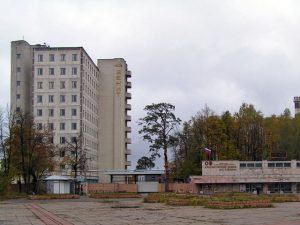
In the next decade, KMZ would produce a number of other optical products including two of the Soviet Union’s most successful cameras, the Zenit SLR and Zorki rangefinder. Other models produced there were the professional Start SLR, the 16mm Narciss SLR, Horizont panoramic camera, and the Iskra 6×6 folding camera.
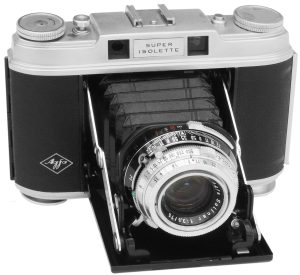
The name Искра (Iskra) means ‘spark’ and was the name of a secret newspaper founded by Lenin in 1900. It was a political newspaper that became the official publication of the Russian Social Democratic Labour Party.
The Iskra camera was a high quality copy of the AGFA Super Isolette, a 6×6 folding rangefinder camera, which first debuted in 1954. It would first make it’s debut in 1959 would be produced until 1963. A second model, called the Iskra-2 would be produced from 1961 through 1964 with the only major change being the addition of an uncoupled selenium exposure meter.
The Iskra, like the Super Isolette camera it copied, was a well featured camera with several features that weren’t common in mid century 6×6 folders, such as a coupled coincident image rangefinder, double exposure prevention, and automatic stop film advance, and automatic resetting exposure counter, a self-timer, and a fully flash synchronized shutter.
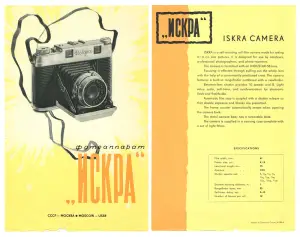
The lens on all variants of the Iskra was a 75mm f/3.5 Industar-58, which was a Tessar design with 4 elements in 3 groups. The shutter was the FXCh-18 which is a copy of the Synchro-Compur found on the Super Isolette.
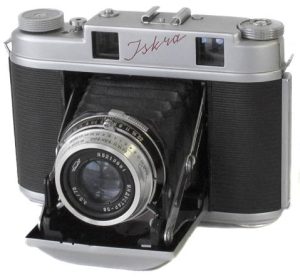
Although a majority of Iskras were sold in the Soviet Union with Cyrillic lettering, there were some export copies made with Latin letters. I was unable to find any reference material showing where or how the Iskra might have been sold, or it’s cost, but the existence of the English language catalog page to the left and a printed manual confirm it was sold outside of the Soviet Union.
Both Iskras were discontinued by 1964 likely due to a decline of demand for a folding medium format rangefinder camera. Photography was increasingly becoming a mainstream industry that required more cost effective models, and factories like KMZ likely saw cameras like the Zenit and Zorki as more practical and profitable.
KMZ would continue to manufacture optical equipment for decades to come. Models like the Start, Drug, Horizon, and Narciss would be some of the most innovative and highest quality of the entire Soviet Union. Unfortunately, due to political and logistical reasons far beyond the scope of this article, quality control would continue to suffer into the 1980s and 90s would fall into disarray after the collapse of the Soviet Union.
Today, KMZ still exists as a huge manufacturer of goods for all industries including Russia’s space program. Cameras produced at KMZ have been used all over the world and while I don’t have any total production numbers for the entire factory, are likely some of the highest of any factory, by any company, ever.
The Iskra is not a well known camera outside of collector’s circles, but perhaps it should be. This is a very well featured and well built model that is the rare example of a Soviet copy that not only matched, but possibly even exceeded the quality of the original.
My Thoughts
When it comes to Soviet-made cameras, the most common models are usually one of the many FED or Zorki rangefinders that were loosely based on the original Leica II. Another model synonymous with Soviet camera design is the Zenit SLR, which interestingly was first based off a Zorki rangefinder so, in a way, even the Zenit owes some of it’s heritage to the Leica as well.
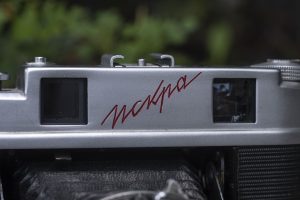
But as anyone who dares venture in the world of Soviet camera collecting, there are many, many more models that were made over the years. All it takes is a brief visit to sites like ussrphoto.com and sovietcams.com before you quickly see how deep the rabbit hole goes.
Many Soviet cameras were based off some other camera’s design. The Lubitel was a copy of the Voigtländer Brillant, the Moskva-1 was a copy of the Zeiss-Ikon Ikonta, and the Zorki 10 was a copy of the Ricohmatic 35. But in the late 1950s, a lesser known Soviet camera called the Iskra-1 was made, which was a copy of the AGFA Super Isolette.
This particular Iskra belongs to Vladislav Kern, owner of ussrphoto.com and was one he recommended I check out in one of my recent visits to his home. Normally, when I peruse his collection, I make requests, but for Vlad to have picked this one out for me, I figured it had to be special.
While there was no shortage of inexpensive 6×6 folding cameras produced all over the world in the mid 20th century, most are pretty basic cameras. The Iskra is not. This is a heavy camera that is loaded with features you don’t often see in this market segment. Weighing in at 855 grams, the Iskra is more than 250 grams heavier than an ANSCO Speedex 6×6 camera.

The top plate is where you get your first clues that the Iskra isn’t just another simple folding camera. From left to right, we have a metal knob with integrated film reminder disc. Although resembling a rewind knob, the purpose of this knob is to lift up while loading film, allowing room for the spool fork to slide into a new roll of 120 film.
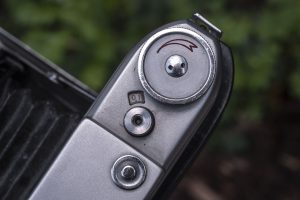
In the middle is an ordinary accessory shoe followed by a chrome button which functions as the release for the front door that is needed to open the camera. On the right is the cable threaded shutter release button, exposure counter, and film advance knob. The presence of a top plate shutter release and exposure counter are things not often seen on lower end folding cameras.
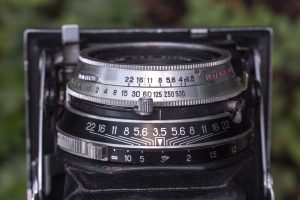
As is the case with most folding leaf shutter cameras, most of the camera’s primary controls are around the shutter. Looking down upon the shutter at waist level and starting near the front of the lens, you have both the aperture f/stop ring and shutter speed ring, which are coupled together using a red numbered EV scale that was popular with Western cameras in the mid 1950s. The EV system was meant to be used with compatible hand held light meters in which an exposure value number was returned by the meter and upon setting any combination of shutter speed and f/stop on the camera, a correct exposure could be obtained. Without a light meter, the EV system could be overridden by choosing any combination of shutter speed and f/stop.
Behind the shutter speed ring is the cocking lever for the shutter, and off to the side a flash sync port. The Iskra, like the Super Isolette it is based off, uses a focusing helix which allows for much more precise focus than unit or front cell focus used on many inexpensive folding cameras. Nearest the bellows is the narrow focusing ring, with distances indicated in meters.
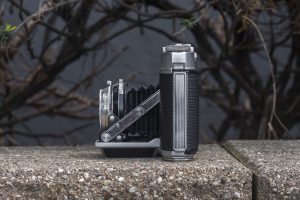
Loading film involves removing the back of the camera which is first opened by releasing the sliding catch on the camera’s left side.
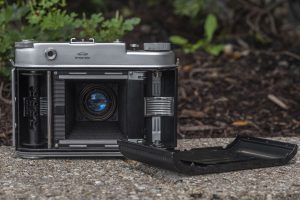
The entire back of the camera is removable which is convenient when loading film, but requires that you have a safe place to set the door aside. Film loads from left to right onto removable 120 spools. Owing to the exposure counter and automatic stop film advance features of the camera, the chambers where both the take up and supply spools are located are very tight.
Loading film into the Iskra requires that the forks that engage each spool are lined up in a specific orientation in order to slide each spool into position. This is likely something to cause the first time user some grief, so I recommend practicing first in a well lit area with empty spools. Once both spools are properly loaded into the camera, the film leader is stretched across the film gate and attached to the take up spool on the right. Turn the film advance knob enough times to ensure that the film leader is not only securely attached to the take up spool, but also that it can travel unimpeded. Once you are sure the film is traveling correctly, reinstall the film door. There is no need to line up arrows or dots with anything on the backing paper like in some 120 film cameras with exposure counters.
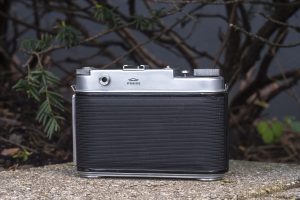
With the back of the camera securely attached, keep turning the film advance knob until you see the number 1 appear in the exposure counter. Assuming the camera is operating correctly, the film advance knob should stop when you are ready for the first exposure. The film transport is one of the most likely failure points of the Iskra so, this is something you want to confirm is working correctly before taking the camera out with fresh film installed.
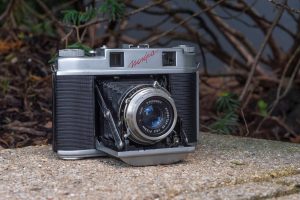
With the camera ready to shoot, you must make sure that you remember to cock the shutter using the cocking lever at the top of the shutter prior to each shot.
The top plate shutter release has a double exposure prevention feature which will only allow you to press the shutter release once, and will not reset until you advance the film again to the next exposure. This means that if you are ready for an exposure, but forget to cock the shutter and press the shutter release, not only will the shutter not fire, but the shutter release button will become locked until you advance the film again, wasting an exposure. This happened to me more than once while shooting, and I was able to overcome it by gently forcing my finger behind the folding strut and pressing the shutter’s actual release lever, near the 8 o’clock position. This is certainly not ideal, but it does work and saves you from wasting an exposure.
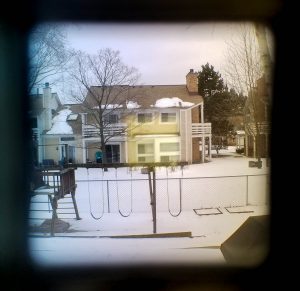
The viewfinder has a square coincident image rangefinder patch in the center of the frame and on this example was large and still very contrasty. If you’re used to 35mm rangefinder cameras, peering through the large opening on the Iskra is a pleasant surprise. I had no problem finding focus using the rangefinder, although the narrowness of the focus ring around the shutter caused me to fumble a few times while out shooting.
The Iskra might have been made in the Soviet Union, and it might have been copied from another camera’s design, but in just a few minutes of handling it, it’s clear that this isn’t just any old Soviet copy. The people who designed and built this model clearly aimed high and mostly delivered. It’s certainly not perfect, but any nitpick I might be able to come up with about it, likely applies to the original as well.
This is a good camera but how does it shoot?
My Results
My time shooting the Iskra was in early 2019 at the tail end of winter and early spring. The weather was still cold and dreary in northwest Indiana, so for the first two rolls through the Iskra, I decided to shoot rolls of expired black and white and color film to maximize the “grit” that seems to be in character with an old Soviet folding camera.
The roll of black and white was Ilford HP5 125 that had expired in the early 2000s, and the color was a roll of Fuji Reala 100 that I didn’t know the age of, but my best guess was late 90s, maybe early 2000s. Since black and white film seems to hold up better over time, I shot the Ilford mostly at 100 and the Reala as if it were a 50 speed film.
Both rolls of film shot in the Iskra were done in less than ideal weather conditions, but the camera performed admirably. The 4-element “Tessar design” Industar lens was as sharp as you’d expect a similar lens made by either a German or Japanese company. Sharpness was even across the frame, and the bluish lens coating resulted in pleasing contrast, especially in black and white. The rangefinder was easy to use and I had no issues getting images in focus, and the shutter was accurate enough to where proper exposure could be obtained using Sunny 16 estimates.
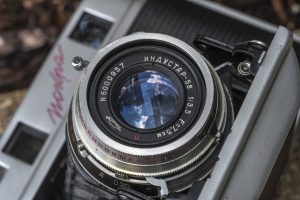
The Iskra was a lot of fun to shoot, and considering the excellent results from the images, it made for an extremely capable and portable camera. This would be the perfect camera for the times you want the quality of a 6×6 Twin Lens Reflex camera, but don’t want the weight or size of a Twin Lens Reflex camera.
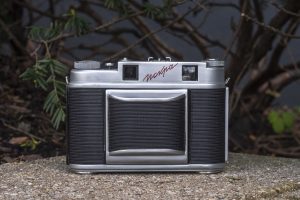
My complaints with the camera all fall into the nitpick category of which there are several. The design of the automatic film advance stop that can’t be reset if you forget to cock the shutter is annoying and something I bet everyone who has ever shot an Iskra has encountered at least once. The film compartment is very tight, and installing film often resulted in me fumbling around more than I would have liked, the focus ring is very narrow and difficult to quickly locate with the camera to your eye, and well, I just hate coupled EV or LV systems that were common in the 1950s.
Those complaints aside, I feel very confident declaring the Iskra to be a very capable and fun Soviet medium format camera. For those out there who thumb their noses at Soviet copies, this one is worth your time, but if you do decide to purchase one, I recommend confirming that the film transport is working before plunking down any roubles. The camera’s owner warned me that many for sale have broken film transports and sometimes, previous owners have modified the cameras to add a red window back into the door so they can count exposures on the backing paper.
Related Posts You Might Enjoy
External Links
http://camera-wiki.org/wiki/Iskra
http://sovietcams.com/index.php?103040997
http://www.ussrcameras.ru/catalog/218
http://ussrphoto.com/Wiki/default.asp?WikiCatID=5&ParentID=1&ContentID=288&Item=Iskra
https://fedka.com/catalog/product_info.php?products_id=612
http://cameras.alfredklomp.com/iskra2/
https://kosmofoto.com/2014/05/marrakech-morocco-film-photography-iskra/


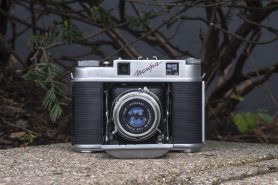


















One of the better picks for a Soviet Era camera. With regards to image quality, the Iskra really is like having a TLR that fits in a coat pocket. Although, it is a bit on the heavy side. You might develop a noticeable to you walk.
Thanks for all the great reviews. I have the Iskra and really like it overall, although the EV scale definitely takes some joy out of the shooting experience.
Do you know if there’s an affordable medium format camera with automatic parallax compensation, excluding TLR’s? The Koni-Omega Rapid fits the criteria (around 200€) but is a “press camera”.
Thanks for the compliments on the Iskra review. Many camera makers put finnicky EV and LVS systems on their cameras which frustrate me. I understand why they were developed, but boy, what a pain!
In regards to your second question, there’s not many. Excludding all TLRs and the excellent Koni-Omega Rapid (which you should not discount for it being a press type camera), you’re really only limited to the SLRs. For 6×6, I still think the Zenza Bronicas are a great value. You can get them for a third the price of a Hasselblad and they use excellent Nikkor lenses. Also using Nikkor lenses are the Mamiya M645 cameras. The earlier ones are more mechanical and less prone to failure, but if you can find one in good shape, they’re awesome to use and since they’re SLRs, there is no parallax error at all.
The Certo Six has parallax correction, but it’s not the viewfinder that’s parallax corrected – the correction is done with the lens. It’s a beautifully constructed folder, with a fabulous lens. The one real weakpoint is the RF mirror decaying (de-silvering). I repaired mine, it wasn’t that hard to replace the RF mirror.
I have the Ansco Super Speedex, a rebadged Super Isolette for the North American market. You should try one of those, as there are some key differences that resolve some of your nitpicks. Namely, shutter speed and aperture are not coupled, and the film spool bolts drop down from the bottom plate for easy loading. I also believe the the shutter and advance are locked out until the shutter is cocked, eliminating that problem. I’ll have to double check on my copy with film in it however. I believe build quality is also in a different league. The one thing is the viewfinder is smaller and somewhat squinty to look through compared to the Iskra.